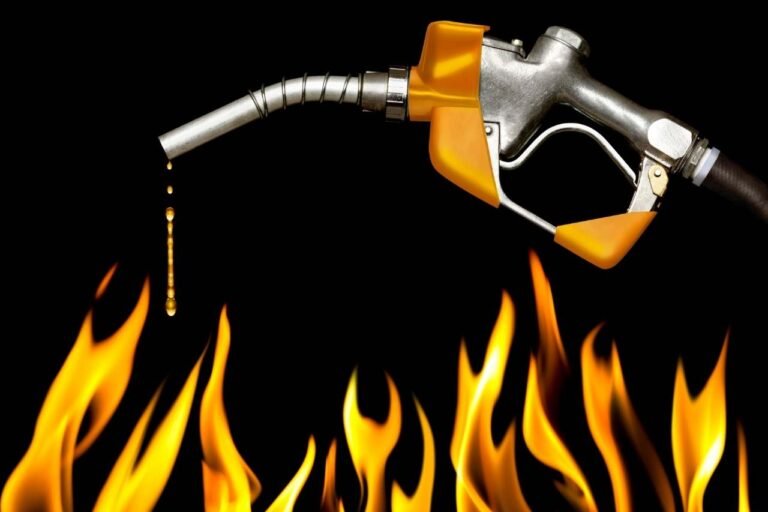Among the most vital parts of our planet is fire. It can bring light or heat or life or death. As a result, it’s critical to understand the significance of both starting and putting out a fire. How to put out a gasoline fire will be the crucial point of discussion today. Fire is a dangerous and unpredictable thing. Therefore, to recognize how to put out a gasoline fire, you must first comprehend the basics of fire. So, let’s get started.
What Is The Fire Triangle?
To start a fire, all three of these portions should be accessible. The main thing to note is that if any of these three factors are removed, the fire would either burn out or die.
Oxygen: To ignite & burn, a fire normally requires a continuous oxygen supply.
Heat: Adequate heat to get the substance to the point of ignition.
Fuel: A fire can be started using any material that can burn—some gasoline or flammable substance.
Different Kinds of fires
The five major types of fires are classified according to the cause of the fire and the kind of fuel used by the fire.
A-class Fire – What Is A-Class Fire?
The fuel for a Class A burning is flammable materials. Solid materials like wood and paper, cloth, and some polymers are examples of these. It’s better to promptly put out a Class A fire with water or ammonium dihydrogen phosphate before it expands. Water, spray, ABC powder, and wet chemical extinguishers are all options.
B-class – What Is B-Class Fire?
Class B fires are those that include flammable liquids or gases. Examples are liquids or gases such as ethanol, methanol, gasoline, or oil. Smothering or eliminating oxygen with spray or CO2 fire extinguishing equipment is the best technique to react to these flames. Foam, CO2 Gas, and ABC Dry Powder are extinguishers that can be utilized.
Moreover, it’s crucial to remember that a gasoline fire is classified as a Class B fire while figuring out how to put out a gasoline fire.
C-class – What Is C-Class Fire?
A fire including electrical equipment is classified as a category C fire. Devices, electronics, and wiring are all examples of electrical failure. If the electronic component were removed, Class C fires would become Class A fires after turning off the power source. Extinguishers that must be utilized include the ABC Dry powder and the CO2 gas.
D-class – What Is D-Class Fire?
Combustible metals are burned in Class D flames. Sodium, titanium, zirconium, and magnesium are examples of metallic substances. The greatest method for suppressing the fire & limiting harm to property or persons is to use dry powder agents. Extinguishers that should be utilized include the Special Dry Powder.
K-class – What Is K-Class Fire?
Foods oils or fat are burned in Class K flames. Grease and oil fires are examples. Water can add to the problem; however, covering the fire or even using the wet agent extinguisher will help. A fire extinguisher that can now be utilized should include a wet chemical.
Did Your Jumper Cables Melt? Here Are The Culprits.
What Is A Gasoline Fire?
Gasoline fire is a fire caused by the presence of vapors or flammable liquids. A gasoline fire happens when a flammable liquid, such as gasoline, kerosene, or jet fuel, ignites and burns in a confined space.
Gasoline fires are the most common type of fire and involve the most dangerous burn patterns on ignition. The three main components of a gasoline fire are 1) vapors, 2) liquid fuel 3) heat. When gasoline is present in the air in 1.4 to 7.6%, it burns.
So, the most common causes of gasoline fires are internal combustion engines, which use a part of a gasoline-powered engine called a cylinder head to burn gasoline and heat the machine.
For example, the combustion chamber of the cylinder head is the area of the engine that is most affected when small amounts of gasoline are ignited. However, if a spark from an electrical wire ignites gasoline vapors on a hot day, a fire will quickly start.
In addition, a gasoline fire can quickly spread, especially if it ignites in a confined space, such as a car trunk or a paper bag. Gasoline fires can also grow significantly larger because of the flammable liquid and the number of fuels available.
Gasoline fires can become difficult to extinguish, especially when many combustible materials, such as furniture, paper, fabrics, and plastics, are involved.
The following is about how to put out a gasoline fire.
How to Put Out A Gasoline Fire?
Putting out a gasoline fire is an important, life-saving task. This task is made even more difficult when it is a fire in a compressed space such as a vehicle engine compartment.
So, how to put out a gasoline fire? Smother the fire with damp rags or sand if possible. A fire blanket should be used to avoid the growth of gasoline flames and to sooth the damage that has already been done. Only a minimal amount of fuel is required for this to work.
Foam or powder extinguishers are required for gasoline fires. Foam is among the most effective ways how to put out a gasoline fire in a liquid fuel tank. It reduces hazardous vapors while also preventing them from finding an igniting source. A coating of foam applied over a gasoline spill can also help to avoid a fire.
Gasoline fires, as we’ve seen, are classified as Class B. Normally, Class B fires are put out by eliminating oxygen, breaking the combustion cycle, or stopping the emission of flammable vapors. Many two different firefighters are suited for large-scale flames caused by gasoline.
Extinguishing equipment that employs chemical powders to extinguish the fire due to a chemical reaction’s neutralizing effect is known as dust extinguishers. Carbon dioxide fire extinguishers use a suffocation effect to extinguish the flames.
Finally, if a property is in danger of fires, you may use this knowledge on how to put out a gasoline fire to create an effective fire protection strategy. Check with a fire safety specialist to ensure that your place is safe. So, we hope everything we declared is clear for you. If not, please drop us a message.
FAQ
Is it possible to put water on even a gasoline fire?
Water will not put out only a gas fire, and it may increase the danger of harm since the intense heat will heat the water nearly instantly, placing you at risk of steam burns.
Is it okay to build a fire using gasoline?
Gasoline should not be used to start or fuel a fire. Although precautions may be made to make it less harmful, utilizing gas near a fire is always dangerous and can even be lethal in the wrong circumstances.
More Related Articles:
- How Long Does Reckless Driving Stay On Your Record?
- How Many Points Is Disobeying A Traffic Control Device?


0 Comments